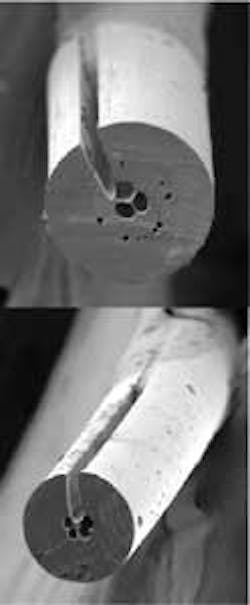MICROSTRUCTURED OPTICAL FIBERS: Sensor uses open slots on holey fibers

Microstructured optical fibers typically consist of a solid core surrounded by a structure of holes in the cladding that run along the length of the fiber. Although fiber sensors can be developed by removing some of the cladding or tapering the fiber to gain access to the evanescent field of the fiber contained in the cladding, researchers at the University of Sydney (Sydney, Australia) and Instituto de Fisica, UNICAMP (Sao Paulo, Brazil) have developed a new type of fiber sensor from a laterally accessible microstructured optical fiber.1
Unlike other microstructured fiber sensors that require an analyte to diffuse into the tiny holes at the endface of the fiber (a slow process even with applied pressure), fluid or gas under test can flow easily into a large slot that is machined laterally with respect to the fiber axis along the fiber holes (see figure). Because the endface of the fiber is not used, illumination can be easily injected into one end of the fiber for in situ monitoring (absorption, fluorescence) while the slotted portion is immersed in the gas or liquid environment. In addition, the fiber ends are free for splicing to other conventional fibers without loss of access to the microstructure.
Fabricating the slot
Two methods to laterally access a holey fiber are laser drilling or by bursting through the wall of the fiber with simultaneous application of heat and pressure. Unfortunately, both techniques produce a hole rather than a continuous slot and so the slow diffusion process is not avoided. Attempting to add lateral holes in the tiny drawn fiber is also risky because of the possibility of damage to the core resulting in fiber losses or mode propagation problems. The researchers adopted a better approach and drilled holes into the fiber preform before it was drawn into fiber. The holes intersect with a single air hole in the cladding of the preform and do not impact the core.
When the 8 cm polymethylmethacrylate (PMMA) preform is drawn into intermediate cane of about 0.6 cm diameter and then sleeved, the holes are drilled into the cane sleeve perpendicular to its axis. Cooling fluid is used when drilling the holes to prevent deformation. The cane is then drawn to the desired outer fiber diameter and each drilled lateral hole becomes stretched to form a slot in the fiber. For a 1-mm-diameter hole drilled into a 0.8-cm-diameter cane, a 5- to 6-mm-long slot is formed in a 150-µm-diameter microstructured optical fiber; the length of the slot is increased by increasing the diameter of the hole drilled in the cane or by drilling overlapping holes in the cane. Varying the width of the slot will change the rate that a chemical species diffuses into the sensing region.
To demonstrate sensing capability, the mid-section of a three-hole 140-µm-diameter fiber with a 40-µm-wide slot width was dipped into a beaker of filtered water containing the pH indicator Bromothymol blue. The transmission spectrum of a supercontinuum source through the fiber was gathered by a spectrophotometer as the solution was varied from basic to acidic. The absorption spectra revealed two spectrally distinct forms of the solution, indicating that the laterally accessible microstructured fiber was able to detect changes in absorption wavelength. This pH sensor is just one demonstration of multiple uses for this slotted fiber.
“We have shown that this new slotted fiber can be used for evanescent-wave sensing applications, but having line-of-sight access to the core of a robust fiber along its length opens up many other exciting possibilities,” says researcher Felicity Cox. “For example, we can now deposit thin films directly on the fiber core by processes such as evaporation, or use plasma treatments to alter the properties of the core surface. As well as exploring such new possibilities in future work, we also plan to continue to develop slotted fibers for sensing.”
REFERENCE
1. F.M. Cox et al., Optics Express15(19) 11843 (Sept. 17, 2007).

Gail Overton | Senior Editor (2004-2020)
Gail has more than 30 years of engineering, marketing, product management, and editorial experience in the photonics and optical communications industry. Before joining the staff at Laser Focus World in 2004, she held many product management and product marketing roles in the fiber-optics industry, most notably at Hughes (El Segundo, CA), GTE Labs (Waltham, MA), Corning (Corning, NY), Photon Kinetics (Beaverton, OR), and Newport Corporation (Irvine, CA). During her marketing career, Gail published articles in WDM Solutions and Sensors magazine and traveled internationally to conduct product and sales training. Gail received her BS degree in physics, with an emphasis in optics, from San Diego State University in San Diego, CA in May 1986.